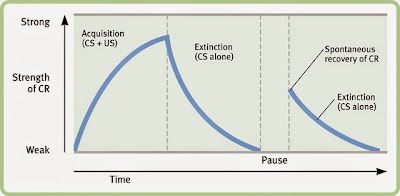Learning
Means any relatively change in behavior brought by experiences or practiceClassical conditioning
Learning to a stimulus other than the original, natural stimulus that normally produces the reflexPavlov's theory

Ivan Pavlov, a Russian psychologist who discovered classical conditioning
Classical Conditioning Concepts
|
Neutral Stimulus (NS) |
A stimulus that does not produce a response. |
|
Unconditioned Stimulus (UCS) |
A stimulus that elicits a response innately or without conditioning. |
|
Unconditioned Response (UCR) |
Automatic response elicited by the unconditioned stimulus. |
|
Conditioned Stimulus (CS) |
A neutral stimulus that when paired with an unconditioned stimulus elicits a similar response. |
|
Conditioned Response (CR) |
A response that is learned by pairing the originally neutral stimulus with the unconditioned stimulus. |
Pavlov's dog model
Other examples of classical conditioning;
|
Terms |
Definition
|
|
Discrimination |
When a CR does not occur, there is a difference between the presented stimulus and the original CS |
|
Extinction |
The extinction phase is when the CR no longer occurs after introduction of the CS. |
|
Generalization |
When there is a small difference in the presented stimulus and the original CS. |
|
Higher-order conditioning |
Refers to a situation in which a stimulus that was previously neutral is paired with a conditioned stimulus to produce the same conditioned response as the conditioned stimulus. |
|
Spontaneous recovery |
Reappeared of a learned response after extinction |
Principles of classical condition :
- CS must be before UCS
- CS and UCS must come very close together (7 seconds)
- CS must be paired with UCS many times before conditioning take place
- CS stand out than other stimuli
Emotional response that become classically conditioning, usually from the association of a relatively neutral stimulus with a painful or fear-inducing experience
When a person becomes nauseated some time after eating a certain food, which then becomes aversive to her/him
When you watch other people's reaction on certain things (in this case fear of riding a roller coaster), you become afraid of it as well.
Operant Conditioning
Learning of voluntary behavior through effects of pleasant and unpleasant consequences to response
"Any behavior that is followed by pleasant consequences is likely to be repeated, and any behavior followed by unpleasant consequences is likely to be stopped."
Thorndike's Law of Effects
Skinner's Box Experiment
How to make punishment more effective?
- Punishment should immediately follow the behavior it is meant to punish
- Must be consistent
- Punishment of the wrong behavior should be paired whenever possible, with reinforcement of the right behavior
Problems with punishment:
- Wrong response (fear of the punisher)
- Tend to lie to avoid punishment
- Does not promote learning
- Hitting by the punisher creates aggression
Observational Learning
Learning behavior by watching or observing
The elements & examples ;















0 comments:
Post a Comment